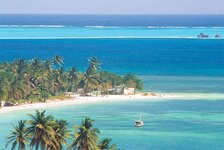Knowing there are so many researches and historians on TreasureNet I have an inconclusive research project that has hit a brick wall and I figured that maybe somebody out there can find a clue or some lead:
It so happens that next year we will be celebrating the 500 year anniversary of the discovery of the islands of Providencia, San Andres and the least known of the three, Santa Catalina (actually she’s a stones throw away from Providencia). Captain Lope de Olano, on the 26 of November 1510, (the day of Sta. Catalina) landed there and on the 30th discovered San Andres Island on the Saints anniversary. Olano apparently had been on Columbus’ second and third voyages and later reappears in 1509 as second in command after Diego de Nicuesa. They get lost in a hurricane, separated and Olano discovers these islands, being court-martialed later on for not rescuing his superior Nicuesa earlier, no justice in those times. Remember that the Archivo General de Indias burnt down in 1551 as Marx so appropriately points out in one of his fascinating books so this venue is of little or no use. What we would like to find out for the anniversary celebrations is the name of the brigantine of Olano in 1510 as there is no known record of this ships name. Any ideas?
It so happens that next year we will be celebrating the 500 year anniversary of the discovery of the islands of Providencia, San Andres and the least known of the three, Santa Catalina (actually she’s a stones throw away from Providencia). Captain Lope de Olano, on the 26 of November 1510, (the day of Sta. Catalina) landed there and on the 30th discovered San Andres Island on the Saints anniversary. Olano apparently had been on Columbus’ second and third voyages and later reappears in 1509 as second in command after Diego de Nicuesa. They get lost in a hurricane, separated and Olano discovers these islands, being court-martialed later on for not rescuing his superior Nicuesa earlier, no justice in those times. Remember that the Archivo General de Indias burnt down in 1551 as Marx so appropriately points out in one of his fascinating books so this venue is of little or no use. What we would like to find out for the anniversary celebrations is the name of the brigantine of Olano in 1510 as there is no known record of this ships name. Any ideas?







